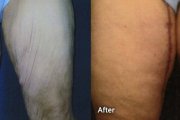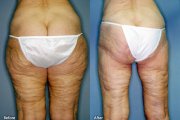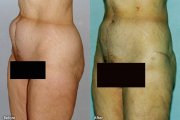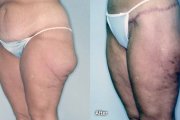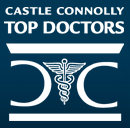Cosmetic Surgical Procedures
Lifting techniques involve removal of skin and fat. Fat can be removed with liposuction, which involves small, difficult to detect scars. However, skin removal requires a longer, more noticeable scar. The longer the scar, the more skin that can be removed. Also, the closer the scar is to the skin being removed, the more effective and accurate the removal will be.
Esthetic considerations often modify the acceptable length and position of scars, so close communication between my patients and me is essential. Scars can be placed longitudinally down the thighs or arms, in the groin or armpit creases, or horizontally or diagonally along the upper, lower or middle buttocks.
That is why I meet with my patients at least twice for 1 ½ hours each time before performing surgery. I spend a lot of time listening to their goals, and explaining benefits, limitations, and possible complications of treatment options.
Body Contouring Treatment and Lifting Techniques
I have performed liposuction since 1983, the year it was approved for general use in the U.S. I use the “superwet” technique for liposuction, rather than the “dry” or “tumnescent” techniques. This technique provides excellent reduction in bleeding, without risks of administering too much fluid.
I do my procedures in surgery centers or hospitals, and only use board-certified anesthesiologists very familiar with liposuction to provide optimal comfort, monitoring and safety. Our body’s metabolism and immune systems work better if normal body temperature is maintained, so the operating room is warmed, a warming blanket is used, and all internal and external solutions are warmed. Sequential compression devices are used to move blood from the calves and prevent blood clots and pulmonary emboli.
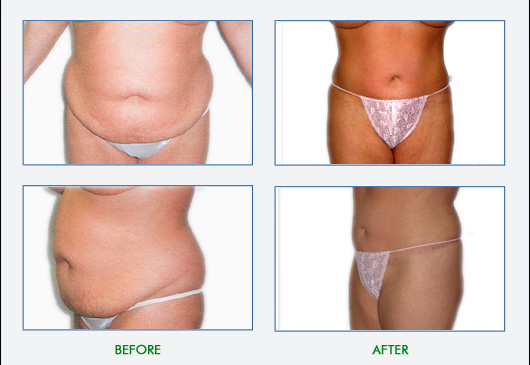
Benefits
- Removes folds of skin and fat
- Improves body proportions
- Improves mobility, hygiene, ease in finding flattering clothing, and comfort
- May improve sexual relations
- Reduces facial jowls and cheek hollowness; eliminates neck wattle
- For women, improves the shape, position and size of breasts; for men, reverses droopiness of breasts and enhances pectoral definition
- Eliminates abdominal folds, improves the shape of the belly button, and tightens stomach muscles
- Improves the shape, size and position of the buttocks
- Eliminates folds of the inner arms, mid-back, lower back, armpits, inner and posterior thighs, and upper and inner knees
Techniques
- These are described in the sections dedicated to different parts of the body. Generally, folds are removed leaving long scars. These scars are placed in body creases whenever possible, so they are less apparent. Sometimes, implants (breast or pectoral), or volumizers (fat transfers, Radiesse or Sculptra) are used to fill in concavities or hollows. This is most common in the cheeks, breasts or buttocks.
- Because the tissue strength and vitality is diminished by stretching from excess weight, extra care is necessary to preserve blood supply and to avoid tension to the wound edges. This is done by not removing too much skin or fat. It is essential to have a plastic surgeon who is very familiar with the characteristics of massive weight loss patients.
- Since large areas of the body are exposed during surgery, it is important to keep patients warm before, during and after surgery. The body’s immune system and metabolism works better at a normal body temperature.
Limitations
- Body contouring is not able to remove excess fat inside of the abdomen. This can only be done with further weight loss.
- Muscles and overlying skin have are thinned by excess weight. There may still be some laxity of skin and muscles even after body contouring procedures.
- It is best not to do too many procedures at one time. Prolonged operations lead to increased complications: pneumonia, blood clots/pulmonary emboli, anemia, and delayed healing.
- Bariatric surgery and intensive diet and exercise programs do not guarantee persistent weight loss. It is usually best to maintain to lost weight about one year before undergoing body contouring procedures.
- Since several areas would often benefit from plastic surgery, it is important to have an overall plan prior to having any surgery. I enjoy providing patients with recommendations about different combinations, so they can reach their goals most rapidly, safely and economically.
Body Contouring Surgery
In summary, I believe that cosmetic surgery should be performed in a setting that maximizes patient safety, comfort, and benefits. My results are enhanced and prolonged when patients practice many forms of self-improvement. Accordingly, I work closely with endocrinologists, dieticians, and trainers.
Dr. Lavey provides creative approaches to skin reduction and fat contouring. For example, in 2005. Dr. Lavey presented a paper to the California Society of Plastic Surgeons on mid-back lifting. In 2009, Dr. Lavey presented “Rehabilitation Following Body Contouring for Massive Weight Loss” at the Plastic Surgery at the Red Sea International Symposium Conference in Eilat, Israel.
Bariatric Surgery
Bariatric surgery or intensive diet and exercise programs may result in loss of over 100 pounds. Large weight loss provides many health benefits. However, patients are usually left with a lot of excess skin (and some excess fat) distributed in folds throughout their bodies. The most common areas are the neck, upper arms, breasts, middle and lower back, buttocks, abdomen and thighs. Treatment involves removing the folds as a wedge of skin and fat. The base of the wedge is in the skin, and the tip extends through the fat to the muscle layer. The resulting defect is repaired with several layers of sutures for strength, and to keep the scars narrow. These “tucking procedures result in long scars. Usually, the scars are hidden in body creases or in areas covered by underwear. Despite the scars, patients are usually eager to trade the large folds for a much better body shape. In addition, rashes and skin irritation are eliminated. It is easier to find attractive clothing and to exercise comfortably.
The best candidates are those who have been at the weight they plan to maintain at least one year. They should also be continuing their dieting and exercise programs. Unfortunately, a significant number of patients will regain some of their weight during the second to fifth years after their weight reduction programs or bariatric surgery. Patients may be disappointed if they regain a lot of weight after plastic surgery. To help maintain or lose weight, I have an occupational therapist in my program who designs a personal training and exercise program for patients. She will start with a customized program, and will modify it if weight gain, boredom, lifestyle or health changes occur. Our commitment is to long-lasting results, and not just to performing surgery. It is also best if patients continue to be monitored and to participate in support groups offered by their weight loss/bariatric program.
Because several areas merit surgery, it is often a good idea to combine several procedures into one operation. Combined procedures are less expensive than the cost of each procedure separately. They also involve fewer days away from work and social obligations, and fewer operations. It is important to discuss your priorities with me, so we can decide which combinations are best. Limits must be placed on the number of areas operated upon and the surgical time. Complications increase and healing is delayed if too many areas are operated on at one time.
It is safest to have surgery in a licensed facility associated with a hospital. To minimize operating time when performing operations on several areas of the body, I usually have another plastic surgeon help in repairing the skin incisions. We have worked together for over twenty-five years.
- The neck wattle and jowls can be treated with neck and cheek lifting (face lifting). The scars are placed in the temple hair, along the crease between the cheek and ear, into the crease behind the ear, and then into the hair behind the ear. A simpler way of treating the neck wattle is with a scar down the middle of the neck. This has the advantage of being a short and relatively inexpensive procedure, but the scar is more noticeable.
- The excess skin and fat of the arms and thighs can be removed leaving a scar along the inner arms or thighs. This tightens the entire length of the arms or thighs. The scars are long and may be exposed by short sleeve shirts, short pants, or bathing suits. The upper 1/3 of the arms may be tightened with a scar in the armpit crease, and the upper 1/3 of the thighs may be tightened with scars in the inner or posterior (back) thigh creases. These scars are easier to hide.
- After large weight loses or pregnancies, a woman’s breasts lose their volume
and shape. Breast reshaping may be achieved with scars around the areolae and down to the folds under her breasts. To increase volume and to provide fullness of her upper breasts, implants filled with silicone or saline are used. For men, excess fat of the breasts may be removed with liposuctioning, or excess skin or fat with a scar horizontally oriented across the breasts and around the lower nipples. - Folds in the abdomen are reduced with tummy tuck procedures. The scars are usually located in the lower abdomen, and they may extend around the back as a “waist lift.” Tummy tuck procedures may also involve using scars placed under a woman’s breasts or in a man’s upper abdomen. These scars are useful if the folds are mostly in the upper abdomen or if there are pre-existing scars in the upper abdomen. Abdominoplasties may also be performed by placing a “H” -shaped scar, with the vertical part going down the middle of the abdomen, and the limbs of the “H” extending along the upper and lower abdomen.
- The back may be tightened with scars in the middle of the back (below a woman’s bra line) or in the lower back. Positioning of the scar depends upon where the largest folds are.
- The buttocks are tightened and lifted using scars going horizontally across the upper buttocks, along the lower buttock-thigh crease, or diagonally across the buttocks. The position of the scars is determined by where the most excess skin and fat is, and by the patients clothing preferences
Laboratory tests are necessary before surgery. A blood count should be performed, because patients following childbirths or having heavy periods, after bariatric surgery or following intensive diets are often anemic. Patients after bypass procedures or following certain diets should be evaluated for vitamin B12 and B6, folate, calcium, iron and protein adequacy. In some patients, heart, liver and kidney function tests are indicated.
Contact Dr. Lavey today and schedule a consultation. Call 925-820-3633






